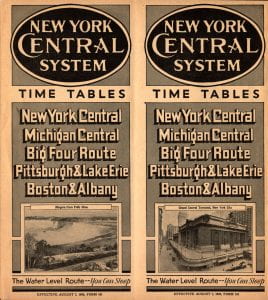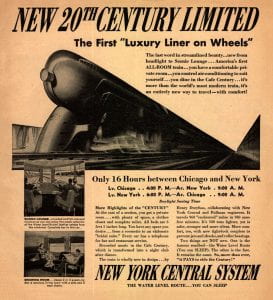
The William R. Hough Timetable Collection represents a passion for collecting in transportation that spans two generations: the donor’s and his father’s. The Transportation Library is excited to share a newly-published finding aid for the collection that comprises 812 timetables for railroads, ships, buses, and airlines that date from 1907 to 2016. The bulk of the collection, rail timetables, reflects the variety of experiences offered on passenger railroads, both in the United States and abroad. In addition to schedules and routes, the timetables are notable for the information they provide about passenger experience factors such as accommodations, services, and rules and regulations. Additionally, information about new routes, expanded schedules, and new equipment — such a 1938 announcement from the New York Central about its new 20th Century Limited — serve as rich illustrations of railroad history.
In a February 1999 interview in Railfan and Railroad, Hough recalled his first memory of long-distance rail travel: a late 1960s family trip from Palo Alto to Glendale on the Southern Pacific’s Coast Daylight. Indeed, Southern Pacific is among the best-represented railroads in the collection. This includes timetables from 1941 and 1947, shown here. The 1947 timetable introduces the railroad to travelers under a section titled Your Friendly Railroad: “The 90,000 men and women of Southern Pacific, the West’s greatest railroad, extend a friendly invitation to see twice as much on your trip across America … Southern Pacific is the only railroad offering your choice of Four Scenic Routes for transcontinental travel: the Sunset Route (New Orleans – Los Angeles – San Francisco), Golden State Route (Chicago – Los Angeles), Overland Route (Chicago – San Francisco), and Shasta Route (San Francisco – Portland).”
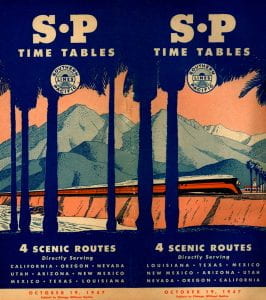
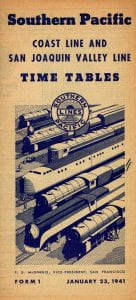
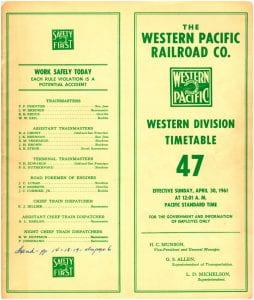
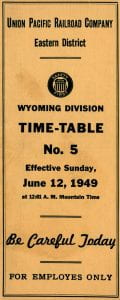 This collection is also significant for its inclusion of employee timetables, including the Western Pacific and Union Pacific timetables shown here. They include both passenger and freight routes and generally follow a standard format popular with timetables of this period: a rectangular page, staple-bound and creased in half to enable folding by conductors and other employees who routinely kept them in a pocket. In addition to the schedules, routes, and information for travelers listed in passenger timetables, employee timetables contained such data as train speed restrictions, watch inspectors, first-aid instructions, and tunnel and bridge clearances, alongside prominent and frequent reminders to exercise safety and caution in one’s work.
This collection is also significant for its inclusion of employee timetables, including the Western Pacific and Union Pacific timetables shown here. They include both passenger and freight routes and generally follow a standard format popular with timetables of this period: a rectangular page, staple-bound and creased in half to enable folding by conductors and other employees who routinely kept them in a pocket. In addition to the schedules, routes, and information for travelers listed in passenger timetables, employee timetables contained such data as train speed restrictions, watch inspectors, first-aid instructions, and tunnel and bridge clearances, alongside prominent and frequent reminders to exercise safety and caution in one’s work.
Of interest as well are the myriad ways that operators depict their networks through maps published as part of timetables. You may know that Harry Beck’s famous 1931 diagrammatic map of the London Underground, inspiration for system maps in decades to come, was inspired by diagrams of electrical circuits. Rarely have we seen the influence of electrical networks more evident in a train map than in the summer 1958 map listing Trans-Europ Express and F-Züge routes.

In contrast, Southern Pacific’s 1941 map is the rare map that includes topography of the region served, with the Sierra Nevada and Coast Ranges featured prominently alongside the rail lines.
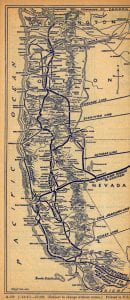
Other representations of route networks include Amtrak’s 1975 intercity map shown below. Maps depicting landmarks from cities or countries served are a common theme; here, Marina City represents Chicago, Man and His World (Expo ’67) represents Montreal, and a charming drawing of Walt Disney World serves as the illustration for Orlando, Florida. 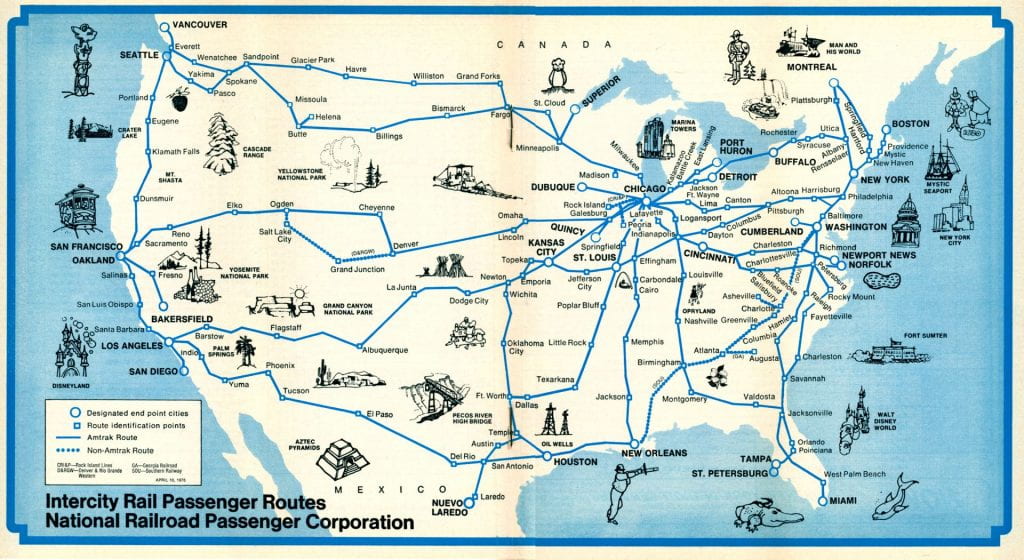
Information in early Amtrak timetables, including the network’s second-ever nationwide schedule from July 12, 1971 (shown below) add rich context to the history of the development of the system, with notes on experimental service introductions and the addition of new routes and more-frequent service. This timetable also includes information for passengers on the development of Amtrak through the passage of the Rail Passenger Service Act in 1970.
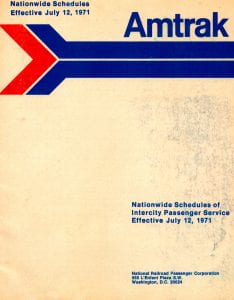
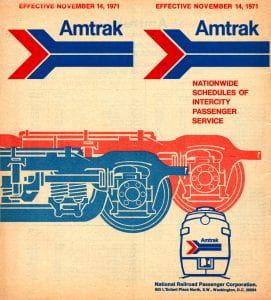
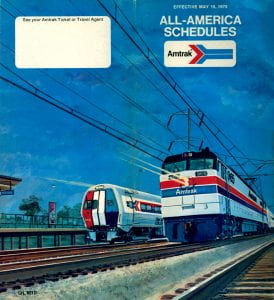
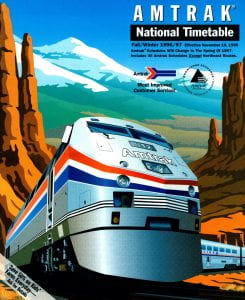
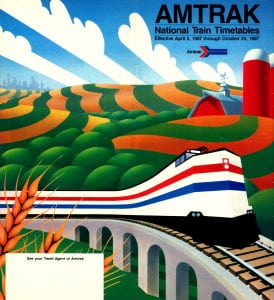
Among the local transit companies appearing in the Hough collection is Pacific Electric, the mass transit system of Southern California that transported passengers with its famous Red Cars. The October 15, 1936 timetable includes information on the company’s Motor Transit Line, Pacific Electric Rail Line, and Pacific Electric Motor Coach Line that extended across the Los Angeles area.
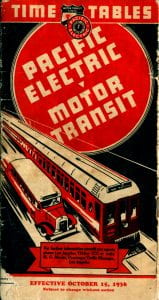
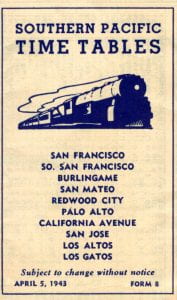
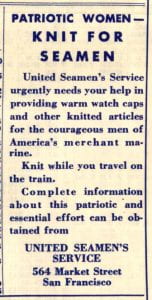 Timetables published during World War II offer a glimpse at wartime travel, jobs, and civilian initiatives. Southern Pacific published a panel “Patriotic Women – Knit for Seamen” in a 1943 timetable, inviting women to knit while they traveled on the train: warm caps and other articles were needed for America’s merchant marine. Timetables published during the war might alternately advertise wartime jobs, remind passengers of the dangers of food waste, or offer celebrate the railroads’ war efforts.
Timetables published during World War II offer a glimpse at wartime travel, jobs, and civilian initiatives. Southern Pacific published a panel “Patriotic Women – Knit for Seamen” in a 1943 timetable, inviting women to knit while they traveled on the train: warm caps and other articles were needed for America’s merchant marine. Timetables published during the war might alternately advertise wartime jobs, remind passengers of the dangers of food waste, or offer celebrate the railroads’ war efforts.
Interurbans are also represented in the collection, as in the case of the North Shore Line  timetable from May 18, 1947. The Chicago North Shore and Milwaukee Railway connected Chicago, Milwaukee, and points in between from 1916 to 1963. This timetable features one of the railroad’s famous Electroliner trains on the pamphlet cover.
timetable from May 18, 1947. The Chicago North Shore and Milwaukee Railway connected Chicago, Milwaukee, and points in between from 1916 to 1963. This timetable features one of the railroad’s famous Electroliner trains on the pamphlet cover.
The 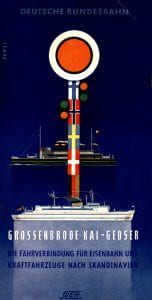 collection includes timetables from a variety of modes of transportation aside from railroads, one of which is shown here: a 1953 timetable from the German Federal Railways listing connections to Denmark, Sweden, Norway, and Finland.
collection includes timetables from a variety of modes of transportation aside from railroads, one of which is shown here: a 1953 timetable from the German Federal Railways listing connections to Denmark, Sweden, Norway, and Finland.
To schedule an appointment to view this collection, which is available on an appointment-only basis to Northwestern patrons and the public, please contact the Transportation Library at transportationlibrary@northwestern.edu or 847-491-5273. For more information on the Transportation Library’s services, collections, and policies for visitors please visit our website.

